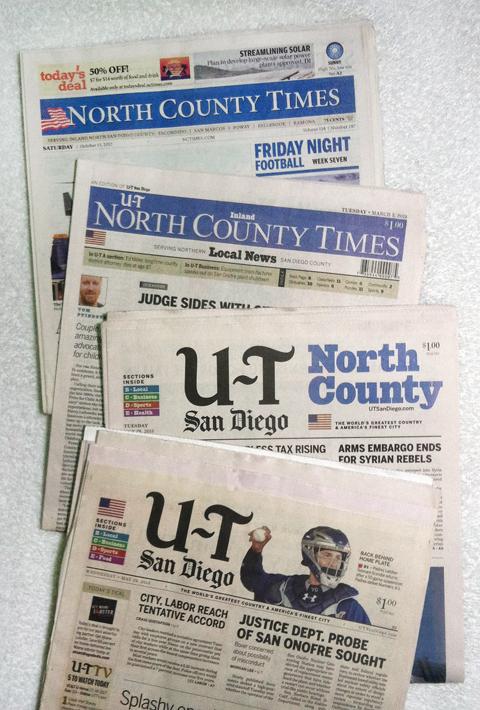The history of the American newspaper is far too large to jam into an 800-word column, but here’s a shot at some of the basics.
The “word-count” of the average daily newspaper such as the Los Angeles Times, Orange County Register or San Diego Union-Tribune amounts to a sizable 200-to-300-page book. Weeklies can be as labor intensive, turning out enough copy to fill a small paperback novel.
The newspaper can be recognized to publish legal documents of recorded judicial, business and governmental minutes for school districts, city councils and county boards. To be officially considered a “publication of record,” county courts “adjudicate” a newspaper for printing legal notices, those governmental minutes and records from school districts, city and county boards, and anything else where public monies have been or are proposed to be spent. These also include marriage, divorce, birth and death notices.
The first American colonial newspaper, Publick Occurrences Both Forreign and Domestick, lasted only one day — Sept. 25, 1690. It was printed in Boston. The British Colonial governor thought it was too radical and had it suppressed after its first edition.
In 1704, some 14 years later, a different governor allowed The Boston News-Letter to be published weekly, and it became the first continuously printed newspaper in the American colonies. Soon after, weekly newspapers, more or less with a commercial slant, began publishing in New York and Philadelphia as well as Boston.
John Peter Zenger was a journalist in New York City who printed The New York Weekly Journal. He was accused of libel in 1734 by William Cosby, the royal governor of New York, but the jury acquitted Zenger, who became history’s symbol for freedom of the press.
Benjamin Franklin’s older brother, James Franklin, launched The New England Courant. It was a distinctive newspaper that annoyed the New England elite while providing reader entertainment and establishing a kind of literary precedent. Benjamin Franklin got his literary start at the Courant.
 Prior to the 1830s, a majority of U.S. newspapers were aligned with a political party or platform. For the most part, that hasn’t changed all that much. In years past, newspapers generally declared political positions on the editorial page(s), keeping the news columns as objective as possible. Unfortunately, writer bias has often crept into news reporting to the point that the term “fake news” has become a commonplace charge by those readers in disagreement on particular editorial positions.
Prior to the 1830s, a majority of U.S. newspapers were aligned with a political party or platform. For the most part, that hasn’t changed all that much. In years past, newspapers generally declared political positions on the editorial page(s), keeping the news columns as objective as possible. Unfortunately, writer bias has often crept into news reporting to the point that the term “fake news” has become a commonplace charge by those readers in disagreement on particular editorial positions.
Since the founding of the nation, daily newspapers have played an important role in American society. San Diego County’s newspapers have been important to our everyday life … that is until the last few years. The advent of the internet has revolutionized delivery of local, state, and international news and opinion.
In 1980, our county had seven daily newspapers and more than double that number in weeklies. Today, San Diego County has only one daily newspaper and but a few remaining newsprint weeklies you can hold in your hands.
Today’s younger generations have never really had a habit of reading a paper-printed newspaper … most get their news online from semi-reliable social outlets or on TV. For most of our lives as older folk (aged 60 years-plus), we have depended upon our local print publications to keep us apprised of what’s happening at our community’s government, the courts and school districts, as well as the business community.
Local dailies are disappearing across the nation and electronic news reports are taking their place. It is predicted that even more daily newspapers will disappear in 2024.
Locally, the now-defunct daily North County Times, at its peak, had a 100,000-plus readership. The 1995 merger of the the Times Advocate in Escondido and the North County Blade-Citizen in Oceanside created the NCT, but daily readership began to slide and the inevitable happened when advertising began to dry up.
The San Diego Union-Tribune purchased the North County Times in 2012 and a few months later ceased its publication, causing dozens of North County staff members to lose their jobs. As a result, North San Diego County no longer has a daily newspaper reporting to its seven suburban cities.
A number of online electronic news reports have joined the last of the area newsprint weeklies, taking the place of the various defunct daily newsprint publications.
For our young people pursuing a career in print journalism, it’ll be tough going as more than half of California’s daily newspapers now are gone. As my generation’s journalists leave the scene, some of our newsprint publications are still with us … sort of … but you’ll have to go to a public library to find them. They’re mostly filed on microfiche records. You can’t hold them in your hand, but you can still view them on a captured photographic page of a chosen date when daily newspapers reported our history of days gone by.
Beware: Today, there are far fewer journalistic eyes and ears monitoring all levels of our government since the demise of our local newspapers. We always end up deserving the kind of government we’ve allowed to take place.
Tom Morrow is a longtime Oceanside-based journalist and author.
Columns represent the views of the individual writer and do not necessarily reflect those of the North Coast Current’s ownership or management.







